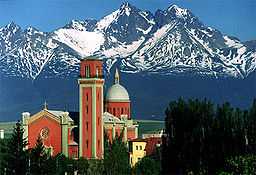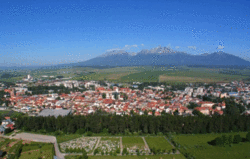Kežmarok
| Kežmarok | ||
| Town | ||
 | ||
|
||
| Name origin: "cheese market" | ||
| Country | Slovakia | |
|---|---|---|
| Region | Prešov | |
| District | Kežmarok | |
| Tourism region | Tatry | |
| River | Poprad | |
| Elevation | 626 m (2,054 ft) | |
| Coordinates | 49°08′01″N 20°25′35″E / 49.13361°N 20.42639°E | |
| Area | 24.83 km2 (9.59 sq mi) | |
| Population | 17,241 (31 December 2005) | |
| Density | 694 / km2 (1,797 / sq mi) | |
| First mentioned | 1251 | |
| Mayor | Igor Šajtlava | |
| Timezone | CET (UTC+1) | |
| - summer (DST) | CEST (UTC+2) | |
| Postal code | 06001 | |
| Area code | +421-52 | |
| Car plate | KK | |
  Location of Kežmarok in Slovakia
| ||
  Location of Kežmarok in the Prešov Region
| ||
| Wikimedia Commons: Kežmarok | ||
| Website: www.kezmarok.sk | ||
| Sources:[1][2] | ||
Kežmarok (German: Kesmark/Käsmark, Hungarian: Késmárk, Polish: Kieżmark, Latin: Kesmarkium) is a town in the Spiš region of eastern Slovakia (population 17,000), on the Poprad River.
History
Settlement at Kežmarok dates back to the Upper Stone Age. In the 13th century the region contained a community of Saxons, a Slovak fishing village, a Hungarian border post and a Carpathian German settlement. Its Latin name was first mentioned in 1251 as Villa (Saxonum apud Ecclesiam) Sancte Elisabeth. In 1269 Kežmarok received its town charter. It also had the right to organize a cheese market (hence the German name Kesmark ("Käsemarkt" - "cheese market"). The terms Nobilissimus (most noble) and nobilissima familia (most noble family) have been used since the 11th century for the King of Hungary and his family, but it were then only a few, among them also Job Zabroczky de Kesmark in the year 1340, which were mentioned in official documents as such. In 1433 the town was severely damaged by a Hussite raid. After 1440, the count of Spiš had a seat in Kežmarok. In the 15th century (and then once more in 1655), Kežmarok became a free royal town.
The town was a stronghold of the noble Thököly family. The Hungarian magnate and warrior Imre Thököly was born in the town in 1657. He died in exile in Turkey in 1705 but in the 20th century his body was returned to Kežmarok and he is buried in a noble mausoleum in the town's Lutheran church.
The town's other monuments include a castle, many Renaissance merchant houses, and a museum of ancient books. In pride of place is the Protestant church built in 1688 entirely of wood. The church also contains an organ of 1719 with wooden pipes. The church has been a UNESCO World Heritage Site since 2008.
Kežmarok had a large ethnic German minority until the end of World War II (see Carpathian Germans). It also had a large and active Jewish community. During World War II, under the auspices of the First Slovak Republic, nearly 3,000 of the town's Jews were deported to German death camps. The town's pre-war Jewish cemetery has now been restored.
Demographics
According to the 2001 census, the town had 17,383 inhabitants. 95.21% of inhabitants were Slovaks, 1.59% Roma, 0.83% Czechs and 0.43% Germans.[3] The religious makeup was 77.50% Roman Catholics, 10.98% people with no religious affiliation, 4.83% Lutherans and 2.63% Greek Catholics.[3]
International relations

Twin towns — Sister cities
Kežmarok is twinned with:[4]
Personalities
- Vojtech Alexander, radiologist
- Lubos Bartecko, ice hockey player
- Karl Sovanka, painter and sculptor
- Radoslav Suchy, ice hockey player
- Imre Thököly, Prince of Transylvania
- Juraj Herz, film director
- Sámuel List medical doctor at Nagyszombat University 1777.[5] Possible relative To Franz Liszt
References
- Notes
- ↑ The Town Kežmarok
- ↑ Mestská a obecná štatistika SR
- ↑ 3.0 3.1 "Municipal Statistics". Statistical Office of the Slovak republic. Archived from the original on 2007-11-16. Retrieved 2007-12-15.
- ↑ 4.0 4.1 4.2 4.3 4.4 4.5 4.6 4.7 4.8 4.9 4.10 "Oficiálne stránky mesta Kežmarok". kezmarok.sk. Retrieved 8 February 2010.
- ↑ Szinney József, Magyar írók élete és munkái, Hornyánszky Budapest 1900
